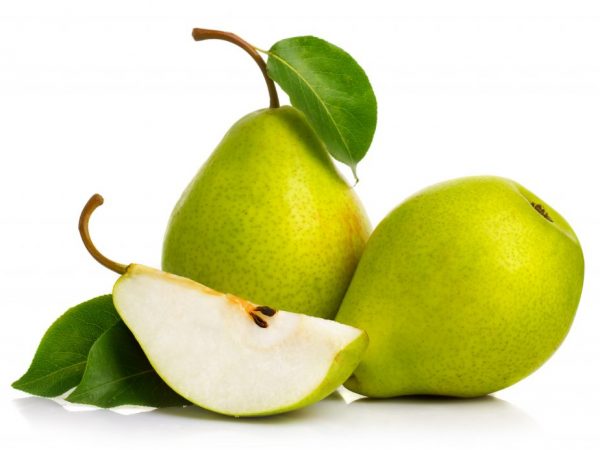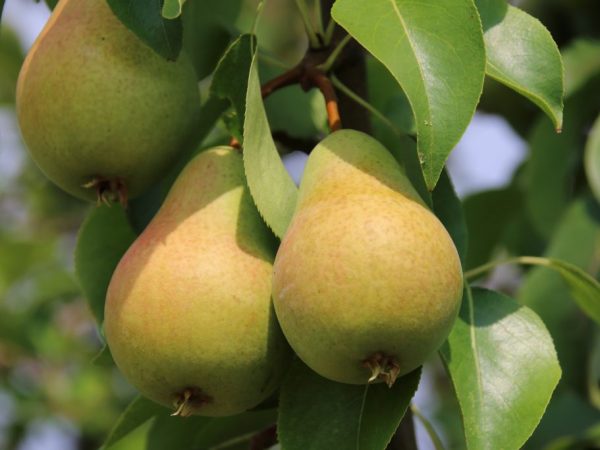Characteristics of pear varieties Sverdlovchanka
Pear of Sverdlovsk is an excellent choice for lovers of sweet fruits. Consider the features of the variety and the rules for caring for the crop.

Characteristics of pear varieties Sverdlovchanka
Variety characteristic
The main advantage of the variety is its large fruits. Thanks to their strong skin, they are easy to transport or store at room temperature for up to 2 weeks.
The disadvantages of the Sverdlovchanka variety include a rather weak resistance to frost in the northern regions. Withstands frosts down to -30 ° C. Another disadvantage is the lack of fruit cover color.
Sverdlovchanka pear varieties are unpretentious in care.
Description of the tree
The trees are low - up to 8 m. They are distinguished by a large pyramidal crown. The branches of the tree are raised up, have a greenish-gray color.
Leaves are oval-ovoid, deep green. They are distinguished by long petioles.
The tree is fast-growing and begins to bear fruit as early as 3-4 years after planting. Has a fairly high yield. Up to 30 kg of pears can be harvested from one tree.
When ripe, the fruits do not crumble, they stick tightly to the branches. Due to the strength of its skin, the fruits are excellently transported, they can be stored at room temperature for up to 2 weeks.
Description of fruits
Fruits are small in size, weight - 130 to 180 g.
In the period of initial maturity, the fruits have a pure green color, and during full ripening they begin to turn slightly yellow. If the fruit is on the sunny side, a slight blush may appear on it.

Fruit appearance
Description of fruits:
- subcutaneous points are well expressed and have a green color;
- the stalks are long;
- the saucer is wide;
- the taste is sweet and sour.
This variety is referred to as dessert. The type is white-yellow. The pear is thin, tender, slightly oily, juicy and aromatic.
The fruits can be used to make desserts or baked goods. They can be consumed fresh or dried. Delicious smoothies or juices are made on the basis of pears. It also makes an excellent wine.
Care
How to plant a pear
The tree is planted in the spring and autumn seasons. In the northern regions, it is advised to produce it in the fall, so that the roots have time to take root in the cold ground.
Before planting, you need to inspect the seedling well. Check for rotten roots or branches. The spoiled ones should be removed immediately, leaving only the good ones.
Black soil or sandy-clay soil is suitable for a seedling. The landing site is prepared in advance, about a week in advance. A hole is being dug, the depth of which is 60-70 cm, and the width is 1 m.
The soil should be loose and fertilized. The roots of the seedling should be located 5-7 cm from the ground.
Watering
After planting, the tree should be watered abundantly. Until the roots of the seedling take root, frequent and regular watering is needed. Then the amount of water should be minimized. The tree is watered when the soil becomes dry. Excessive watering will lead to root rot.
Top dressing
The seedling must be fertilized regularly. Basically, feeding is carried out in the 2nd year after planting in the autumn.It is also recommended to fertilize the tree throughout the summer.
Procedure for feeding:
- Fertilizers are placed in small trenches. They are made during tree planting.
- It is best to use peat or humus fertilizer. It is mixed with earth.
- The resulting mixture is spread around the entire perimeter of the trench.
For fertile soils, a mixture of organic and mineral fertilizers should be used. An excellent result is obtained by a combination of 6 kg of compost, 55 g of superphosphate, 25 g of potassium salt. This is enough for 1 m2.
It is recommended to fertilize depleted soils with humus and superphosphate. Additional components - sand, potassium. Add the mixture to 1 planting pit.

Pear care
Pruning
Pruning is recommended in the spring so that the tree bears better fruit. If pruning is done in the fall, there is a risk that the plant will freeze.
When pruning a tree, it is best to use the thinner half of the secateurs. This contributes to the formation of quality fruits. Another plus - the branches will not be too overloaded with pears.
Diseases and pests
The tree is resistant to diseases, parasites and pests.
For prevention, you need to do the following:
- To clear the weeds from the near-trunk circle, because some may contain parasites.
- Loosen the soil frequently. You need to dig up the soil around the tree once a week after watering. This will help oxygenate the soil.
- Fertilize. By feeding, the grower helps the tree to be more resistant to pests and diseases. The right fertilizer can improve the condition of the soil.
- Remove foliage from the trunk circle. The goal is to prevent the appearance of weeds and parasites in them.
The description of the variety says that due to improper care, the tree can be affected by powdery mildew or sooty fungus. To remove them, you need to treat the tree first with soapy water, and later with tobacco. In the case of powdery mildew, damaged branches and leaves must be removed immediately and then burned. This will help prevent the spread of the disease to other seedlings.
Conclusion
Sverdlovchanka pear variety has good frost resistance and excellent yield. Differs in resistance to diseases and pests.


